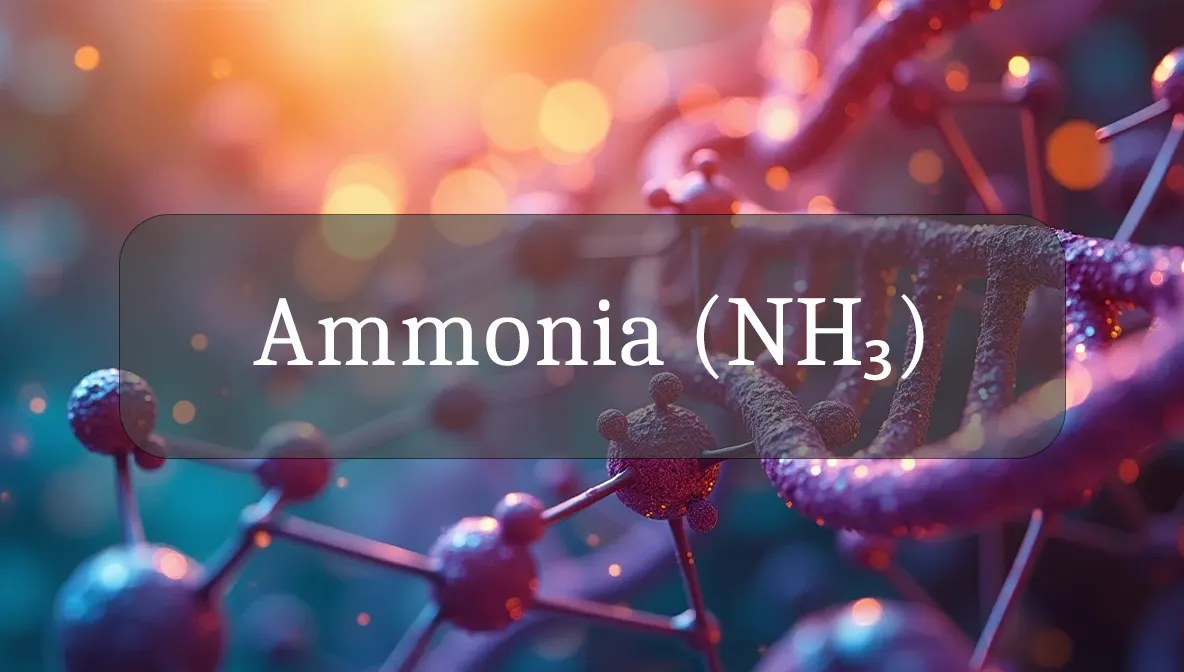Body’s Metabolic Byproduct
Ammonia (NH₃) is a small, pungent gas produced in your body as a byproduct of protein metabolism. While essential to clear as part of normal physiology, its accumulation can be toxic, making its regulation critical for health. Let’s explore what ammonia is, its role in your wellness, and how to support its safe management for daily vitality.
Identity and Function
Ammonia is a nitrogen-containing molecule (~17 Da) formed when proteins or amino acids are broken down. In the body, it’s primarily produced in the liver, gut, and muscles during amino acid catabolism or by gut bacteria metabolizing dietary proteins. Ammonia is toxic at high levels, so the liver rapidly converts it into urea via the urea cycle for safe excretion by the kidneys. Alternatively, it can be used to synthesize glutamine, a non-toxic carrier molecule, in tissues like muscles or the brain.
Biological Role and Health Impact
Ammonia has no direct beneficial role but is a natural byproduct with significant health implications:
- Protein Metabolism: It’s generated when amino acids are broken down for energy, gluconeogenesis, or tissue repair, supporting metabolic flexibility during fasting or exercise.
- Nitrogen Balance: Its conversion to urea ensures safe nitrogen excretion, preventing toxicity and maintaining acid-base balance.
- Brain Function (Indirect): Low levels of ammonia are normal, but excess can disrupt neurotransmission, leading to neurological symptoms like confusion or seizures.
- Gut Microbiome Activity: Gut bacteria produce ammonia from dietary proteins, influencing gut pH and microbial balance, which impacts digestion and immunity.
- Detoxification Demand: Efficient ammonia clearance by the liver and kidneys is crucial to prevent systemic toxicity, supporting organ health.
By ensuring ammonia is quickly processed, your body maintains energy, metabolic balance, and neurological health.
Production and Sources
Ammonia is produced internally and influenced by diet and metabolism:
- Endogenous Production:
- Liver/Muscles: Amino acid breakdown during protein catabolism releases ammonia, especially during fasting, exercise, or stress.
- Gut: Bacteria in the colon metabolize undigested proteins or urea, producing ammonia, which enters the bloodstream via the portal vein.
- Other Tissues: Small amounts are generated in kidneys or brain during metabolic processes.
- Dietary Influence: High-protein foods (e.g., meat, eggs, beans) increase ammonia production via amino acid breakdown or gut fermentation. Low-fiber diets may amplify gut ammonia production.
- Key Nutrients: B vitamins (B6 in fish, B3 in grains), zinc (nuts, seeds), and magnesium (spinach, almonds) support urea cycle enzymes. Hydration aids urea excretion.
- External Sources: Ammonia is found in cleaning products, fertilizers, or industrial settings, but inhalation or skin exposure is toxic and unrelated to biological ammonia.
A balanced diet and healthy liver function optimize ammonia clearance.
Signs of Imbalance
Ammonia imbalances, typically from impaired clearance, can lead to serious health issues:
- Hyperammonemia (High Ammonia Levels):
- Symptoms: Confusion, lethargy, tremors, or seizures, progressing to coma in severe cases.
- Causes: Liver disease (e.g., cirrhosis, hepatitis), urea cycle disorders (genetic, rare), or severe infections (e.g., sepsis).
- Blood ammonia >50 µmol/L (normal: 10–50 µmol/L) indicates toxicity, often with neurological or gastrointestinal symptoms.
- Chronic Low-Grade Elevation:
- Fatigue, brain fog, or irritability, often in liver dysfunction or high-protein diets with poor gut health.
- Bad breath or digestive discomfort from gut-derived ammonia.
- Low Ammonia (Rare):
- Not typically problematic, as ammonia is a waste product; low levels may reflect reduced protein intake or metabolism.
If you experience neurological symptoms, fatigue, or digestive issues, see a doctor for tests like blood ammonia levels, liver function, or genetic screening for urea cycle disorders.
Supporting Healthy Function
To manage ammonia levels and support detoxification:
- Eat a Balanced Diet: Aim for moderate protein (0.8–1.2g/kg body weight; e.g., chicken, tofu) to minimize excess ammonia. Include fiber-rich foods (oats, beans, apples) to reduce gut ammonia production by promoting healthy microbiota.
- Stay Hydrated: Drink 8–12 cups of water daily to support kidney function and urea excretion, flushing ammonia-derived waste.
- Support Liver Health: Limit alcohol (1 drink/day for women, 2 for men), avoid smoking, and eat antioxidants (berries, spinach) to protect liver function and urea cycle efficiency.
- Exercise Moderately: Aim for 30 minutes most days (e.g., walking, yoga) to enhance muscle glutamine synthesis, which buffers ammonia, but avoid overtraining, which increases production.
- Monitor Gut Health: Consume probiotics (yogurt, kefir) and prebiotics (garlic, onions) to balance gut bacteria, reducing ammonia production in the colon.
Safety and Precautions
Ammonia is a natural byproduct, but health conditions or exposures require care:
- Medical Conditions: Liver disease, urea cycle disorders, or kidney dysfunction impair ammonia clearance, needing medical management (e.g., lactulose, low-protein diets).
- Medications: Drugs like valproic acid or chemotherapy can raise ammonia levels. Use as prescribed and monitor with your doctor.
- High-Protein Diets: Excessive protein (>2g/kg/day) can overload the urea cycle, especially in liver or kidney issues. Consult a dietitian.
- External Exposure: Inhaling ammonia gas (e.g., from cleaners) causes respiratory irritation or burns. Use in well-ventilated areas with protective gear.
- Emergency Signs: Seek immediate care for hyperammonemia symptoms (e.g., confusion, seizures), as it can be life-threatening.
If you have neurological symptoms, liver issues, or concerns about protein intake, consult a healthcare provider for tests like ammonia levels or metabolic panels.
Fun Fact
Did you know your body turns ammonia into a safe “package” faster than you can blink? The liver’s urea cycle can process ammonia into urea in seconds, keeping your brain and body safe from this sneaky toxin!
Citations
- National Institutes of Health (NIH): Ammonia Metabolism and Hyperammonemia.
- Mayo Clinic: Liver Disease and Ammonia Toxicity.
- Cleveland Clinic: Urea Cycle and Protein Metabolism.
- Journal of Hepatology: Ammonia in Health and Disease (2020).
- Frontiers in Microbiology: Gut Ammonia and Microbiome (2021).

